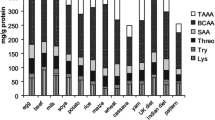Abstract
The increasing demand for gluten-free products has favoured the design of numerous gluten-free bakery products which intended to mimic the quality characteristics of wheat bakery products. The objective of this study was to evaluate the nutritional pattern of gluten-free breads representative of the Spanish market for this type of products. The protein, fat and mineral content of the gluten-free breads showed great variation, ranging from 0.90 to 15.5 g/100 g, 2.00 to 26.1 g/100 g and 1.10 to 5.43 g/100 g, respectively. Gluten-free breads had very low contribution to the recommended daily protein intake, with a high contribution to the carbohydrate dietary reference intake. Dietary fiber content also showed great variation varying from 1.30 to 7.20 g/100 g. In vitro enzymatic hydrolysis of starch showed that the most predominant fraction was the rapidly digestible starch that varied from 75.6 to 92.5 g/100 g. Overall, gluten-free breads showed great variation in the nutrient composition, being starchy based foods low in proteins and high in fat content, with high glycaemic index.


Similar content being viewed by others
References
Catassi C, Fasano A (2008) Celiac disease. In: Arendt EA, Dal Bello F (eds), Gluten-Free Cereal Products and Beverages. London/San Diego:Elsevier, pp 1–27.
Pruska-Kędzior A, Kędzior Z, Gorący M, Pietrowska K, Przybylska A, Spychalska K (2008) Comparison of rheological, fermentative and baking properties of gluten-free dough formulations. Eur Food Res Technol 227:1523–1536
Gujral H, Rosell CM (2004) Functionality of rice flour modified by microbial transglutaminase. J Cereal Sci 39:225–230
Lazaridou A, Duta D, Papageorgiou M, Belc N, Biliaderis CG (2007) Effects of hydrocolloids on dough rheology and bread quality parameters in gluten-free formulations. J Food Eng 79:1033–1047
Marco C, Rosell CM (2008) Functional and rheological properties of protein enriched gluten-free composite flours. J Food Eng 88:94–103
Ribotta PD, Ausar SF, Morcillo MH, Pérez GT, Beltrano DM, León AE (2004) Production of gluten-free bread using soybean flour. J Sci Food Agric 84:1969–1974
Calderón de la Barca AM, Rojas-Martínez ME, Islas-Rubio AR, Cabrera-Chávez F (2010) Gluten-free breads and cookies of raw and popped amaranth flours with attractive technological and nutritional qualities. Plant Food Hum Nutr 65:241–246
Akubor PI, Adamolekun FO, Oba CA, Obari H, Abudu IO (2003) Chemical composition and functional properties of cowpea and plantain flour blends for cookie production. Plant Foods Hum Nutr 58:1–9
Marco C, Rosell CM (2008) Breadmaking performance of protein enriched, gluten-free breads. Eur Food Res Technol 227:1205–1213
Thompson T, Dennis M, Higgins LA, Lee AR, Sharret MK (2005) Gluten-free diet survey: Are Americans with celiac disease consuming recommended amounts of fibre, iron, calcium and grain foods? J Hum Nutr Dietetics 18:173–179
ICC (1994) Official Methods of Analysis. International Association for Cereal Chemistry, Vienna
FAO (2003) Food energy-methods of analysis and conversion factors. Food and Agriculture Organization of the United Nations, Rome
AACC International (2000) Approved Methods, 11th edn. American Association of Cereal Chemists International, St Paul
Arocha Gularte M, Rosell CM (2011) Physicochemical properties and enzymatic hydrolysis of different starches in the presence of hydrocolloids. Carbohyd Polym 85:237–244
Englyst HN, Veenstra J, Hudson GJ (1996) Measurement of rapidly available glucose (RAG) in plant foods: A potential in vitro predictor of the glycaemic response. Br J Nutr 75:327–337
Goñi I, Garcia-Alonso A, Saura-Calixto F (1997) A starch hydrolysis procedure to estimate glycemic index. Nutr Res 17:427–437
Granfeldt Y, Björck I, Drews A, Tovar J (1992) An in vitro procedure based on chewing to predict metabolic responses to starch in cereal and legume products. Eur J Clin Nutr 46:649–660
Moore MM, Schober TJ, Dockery P, Arendt EK (2004) Textural comparisons of gluten-free and wheat-based doughs, batters, and breads. Cereal Chem 81:567–575
Yazynina E, Johansson M, Jägerstad M, Jastrebova J (2008) Low folate content in gluten-free cereal products and their main ingredients. Food Chem 111:236–242
Rosell CM (2011) The science of doughs and bread quality. In: Preedy VR, Watson RR, Patel VB (eds) Flour and breads and their fortification in health and disease prevention. London: Elsevier, pp 3–14
NRC (2001) Dietary Reference Intakes table-The complete set http:www.iom.edu/?id=21381.
Škrbić B, Milovac S, Dodig D, Filipčev B (2009) Effects of hull-less barley flour and flakes on bread nutritional composition and sensory properties. Food Chem 115:982–988
Korus J, Witczak M, Ziobro R, Juszczak L (2009) The impact of resistant starch on characteristics of gluten-free dough and bread. Food Hydrocolloids 23:988–995
Thompson T (2000) Folate, iron, and dietary fiber contents of the gluten-free diet. J Am Diet Assoc 100:1389–1396
Saura-Calixto F, García-Alonso A, Goñi I, Bravo L (2000) In vitro determination of the indigestible fraction in foods: An alternative to dietary fiber analysis. J Agric Food Chem 48:3342–3347
Poutanen K, Flander L, Katina K (2009) Sourdough and cereal fermentation in a nutritional perspective. Food Microbiol 26:693–699
Jenkins DJA, Wolever TMS, Leeds AR, Gassull MA, Haisman P, Dilawari J, Goff DV, Metz GL, Alberti KM (1978) Dietary fibres, fibre analogues, and glucose tolerance: Importance of viscosity. Br Med J 1:1392–1394
Gelencsér T, Gál V, Hódsági M, Salgó A (2008) Evaluation of quality and digestibillity characteristics of resistant starch-enriched pasta. Food Bioprocess Tech 1:171–179
Bernal MJ, Periago MJ, Ros G (2002) Effects of processing on dextrin, total starch, dietary fiber and starch digestibility in infant cereals. J Food Sci 67:1249–1254
Fardet A, Leenhardt F, Lioger D, Scalbert A, Rémésy C (2006) Parameters controlling the glycaemic response to breads. Nutr Res Rev 19:18–25
Acknowledgments
Authors acknowledge the financial support of Association of Coeliac Patients (Madrid, Spain), Spanish Scientific Research Council (CSIC) and the Spanish Ministerio de Ciencia e Innovación (Project AGL2008-00092/ALI). ME Matos would like to thank predoctoral grant by the Council of Scientific and Humanistic Development of University Central of Venezuela (Caracas, Venezuela).
Author information
Authors and Affiliations
Corresponding author
Rights and permissions
About this article
Cite this article
Matos Segura, M.E., Rosell, C.M. Chemical Composition and Starch Digestibility of Different Gluten-free Breads. Plant Foods Hum Nutr 66, 224–230 (2011). https://doi.org/10.1007/s11130-011-0244-2
Published:
Issue Date:
DOI: https://doi.org/10.1007/s11130-011-0244-2




